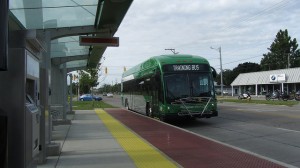Less than stellar state transportation funding outcome has 3 bright spots

The transportation funding package Gov. Snyder signed into law on Tuesday brought a disappointing end to the years-long debate over how to raise much-needed funding for Michigan’s transportation system.
The approved package has many serious failures. For example:
- It only guarantees $600 million in new, dedicated revenue for our transportation system—far from the $1.2 billion the package claims to generate. The other half of the funding increase depends on projected general fund growth and relies on future legislators to appropriate that money to our roads versus other priority state programs with growing fiscal needs. It’s far from certain that such revenue growth will occur, or that future lawmakers will come up with the remaining funds when faced with other important demands on the general fund.
- Any money appropriated from the general fund will go to roads only, and will not add to the Comprehensive Transportation Fund (CTF), which supports local bus agencies and passenger rail.
- Furthermore, funding increases will be slowly phased in over the next six years. The short of it: Don’t expect to see major improvements to our crumbling roads and bridges anytime soon.
Still, despite the well-deserved criticism of the outcome, there are a few bright spots worth highlighting:
1. New money for public transit. For the first time since 1987, the CTF will see a structural increase in funding. (By structural increase, we mean an increased slice of the transportation-funding pie. Transit may have seen overall increases in some years, but only because the pie itself grew, due to more fuel purchased or other factors.)
All new revenue from the 20 percent increase in vehicle registration fees and a 7.3-cent increase in the fuel tax (but not the general fund revenue) will pass through the full Act 51 formula, which means the CTF will get its fair share of the funding. In several previous iterations of this package, the CTF was completely cut out of any increase.
The CTF will see $35 million in new funding beginning in 2016. The new revenue will continue to grow through 2021, when the increase levels off at $54.6 million per year—a 22 percent increase over current funding levels. The DNR recreation fund, another pot of money within the Act 51 formula that supports trails and waterways, will grow by $6.5 million per year by 2021.
While $54.6 million is a small portion of the larger pot of transportation funding money, it will make a big impact on our state’s transit systems. The increase means that local bus agencies will see a bump in their state support, which will likely yield more stable funding for existing service. The added funds could also support expansions like the $4.4 million funding increase for service expansions in the Ann Arbor area or larger projects like the $40 million bus rapid transit line in Grand Rapids.
2. Detroit can flex some of its road money to transit. The nearly 100,000 daily riders of the underfunded and notoriously unreliable DDOT bus system could see more relief if Detroit takes advantage of the new option to flex 20 percent of its local road money, or about $11 million, to support public transit. The Act 51 formula steers roughly 10 percent of state transportation funding to public transportation, but—recognizing the importance of good transit to the city’s economic rebound—the Senate’s Detroit caucus included a provision in the new bill package that allows the city to allocate up to 20 percent of its local road money to transit.
DDOT recently upgraded its fleet and hired more drivers. In a recent Detroit Free Press article, Detroit’s director of governmental affairs said new money could be used to restore 24-hour bus service and expand routes, which would likely bring continued increases in ridership.
3. A softer blow to the hybrid and electric vehicle industry. Although we don’t think hybrid and electric vehicle owners should pay any more in registration fees than other auto owners, the fee increases passed by the Legislature last week were reduced to $30 for hybrids and $100 for electric vehicles (originally $100 for hybrids and $200 for electrics).
Additionally, the definition of hybrid vehicles has been altered to only include plug-in hybrids using a battery storage system of at least 4 kilowatt hours. This would exclude most garden-variety “hybrids” on the road today.
The transportation funding package that’s now law certainly doesn’t check off everything on our wish list. A successful transportation funding package would have raised the $1.2 billion with most (if not all) funding coming from new, dedicated sources that passed through the full Act 51 formula. Serious concerns remain about whether the slowly phased-in new revenue will be enough to fix our roads, and about how—and if—future lawmakers will come up with the general fund dollars that make up the bulk of the funding plan.
Still, these few components of the package provide a glimmer of hope that Michigan lawmakers are beginning to understand the importance of supporting transit, trails and the rest of our complete transportation system.
###
Photo courtesy John Eisenschenk via Flickr.



Comments are closed.